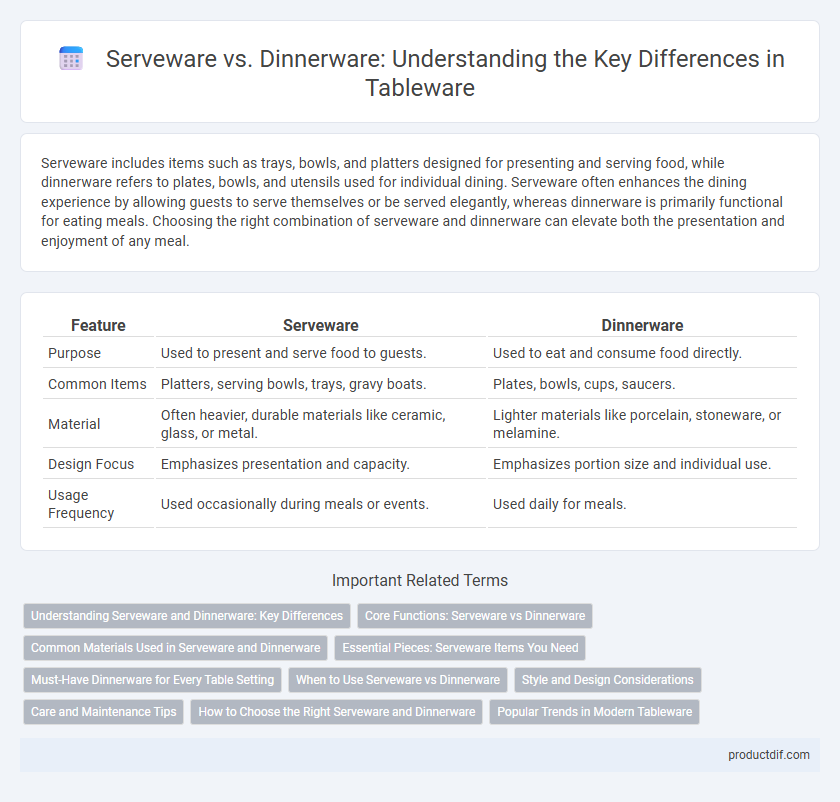Serveware includes items such as trays, bowls, and platters designed for presenting and serving food, while dinnerware refers to plates, bowls, and utensils used for individual dining. Serveware often enhances the dining experience by allowing guests to serve themselves or be served elegantly, whereas dinnerware is primarily functional for eating meals. Choosing the right combination of serveware and dinnerware can elevate both the presentation and enjoyment of any meal.
Table of Comparison
| Feature | Serveware | Dinnerware |
|---|---|---|
| Purpose | Used to present and serve food to guests. | Used to eat and consume food directly. |
| Common Items | Platters, serving bowls, trays, gravy boats. | Plates, bowls, cups, saucers. |
| Material | Often heavier, durable materials like ceramic, glass, or metal. | Lighter materials like porcelain, stoneware, or melamine. |
| Design Focus | Emphasizes presentation and capacity. | Emphasizes portion size and individual use. |
| Usage Frequency | Used occasionally during meals or events. | Used daily for meals. |
Understanding Serveware and Dinnerware: Key Differences
Serveware refers to items designed for presenting and serving food, such as platters, bowls, and serving utensils, whereas dinnerware includes plates, bowls, and cups intended for individual consumption. Serveware emphasizes functionality for food display and portioning, often featuring larger sizes and communal use, while dinnerware is tailored for personal dining settings with standardized portion sizes. Recognizing these distinctions helps optimize table presentation and enhances the dining experience by matching appropriate items to serving or eating needs.
Core Functions: Serveware vs Dinnerware
Serveware primarily functions to present and serve food, featuring items like trays, bowls, and platters designed for easy access and sharing. Dinnerware serves as the collection of dishes, including plates, bowls, and mugs, intended for individual consumption during meals. Both play distinct roles in dining, with serveware enhancing food presentation and dinnerware providing the necessary vessels for eating.
Common Materials Used in Serveware and Dinnerware
Serveware and dinnerware commonly utilize materials such as ceramic, porcelain, glass, stainless steel, and melamine, each offering durability and aesthetic appeal. Porcelain and ceramic dominate dinnerware for their heat retention and elegant finish, while serveware often incorporates stainless steel and glass for versatility and durability during food presentation. Melamine serves as a practical choice in both categories, favored for its shatter-resistant properties and ease of maintenance.
Essential Pieces: Serveware Items You Need
Serveware essential pieces include serving bowls, platters, and gravy boats, designed to present and distribute food efficiently during meals. Unlike dinnerware, which consists of plates, bowls, and cutlery used for individual servings, serveware enhances the dining experience by facilitating communal sharing and convenience. Key serveware items also encompass serving utensils like tongs and ladles, crucial for hygienic and stylish food presentation.
Must-Have Dinnerware for Every Table Setting
Must-have dinnerware includes essential pieces such as dinner plates, salad plates, bowls, and mugs, forming the foundation of every table setting. High-quality ceramics, porcelain, or earthenware offer durability and aesthetic appeal, suitable for daily use and special occasions. Versatile designs in neutral tones or classic patterns ensure seamless integration with serveware for a cohesive dining experience.
When to Use Serveware vs Dinnerware
Serveware is best utilized for presenting and serving food during gatherings, making it essential for buffet-style meals and formal occasions where dishes are shared. Dinnerware is designed for individual use, providing a personal setting for eating and is ideal for everyday meals and plated courses. Understanding the distinction ensures appropriate use, enhancing dining experience and table aesthetics.
Style and Design Considerations
Serveware often features bold, decorative designs intended to complement the table setting while enhancing food presentation, with materials ranging from ceramics to metals that prioritize both aesthetics and functionality. Dinnerware typically emphasizes cohesive patterns and color schemes that coordinate with overall dining room decor, offering a balance between elegance and everyday usability. Choosing between serveware and dinnerware styles depends on the desired visual impact and practical use during meals, with serveware favoring statement pieces and dinnerware focusing on harmonious, versatile designs.
Care and Maintenance Tips
Serveware requires gentle hand washing and immediate drying to preserve delicate finishes and prevent tarnish, especially for materials like silver or wood. Dinnerware, often dishwasher-safe, benefits from avoiding harsh detergents and sudden temperature changes to prevent chipping or cracking. Both serveware and dinnerware maintain longevity by storing in dry, temperature-controlled environments and using soft cloths for polishing or cleaning.
How to Choose the Right Serveware and Dinnerware
Choosing the right serveware and dinnerware depends on the occasion, material durability, and design compatibility with your existing table setup. Serveware should prioritize functionality and ease of use, with items like platters and bowls designed for serving different types of dishes, while dinnerware focuses on individual plates and bowls optimized for portion sizes and presentation. Opt for materials such as porcelain, stoneware, or melamine based on factors like microwave safety, dishwasher compatibility, and resistance to chipping for long-lasting usability.
Popular Trends in Modern Tableware
Serveware and dinnerware have evolved with modern tableware trends emphasizing multifunctionality and sophisticated aesthetics. Popular materials like stoneware and porcelain are favored for their durability and elegance, while designs increasingly feature minimalist patterns and muted earth tones to complement contemporary dining spaces. Smart serveware innovations now include temperature-retaining features and modular sets to enhance both presentation and convenience.
Serveware vs Dinnerware Infographic

 productdif.com
productdif.com